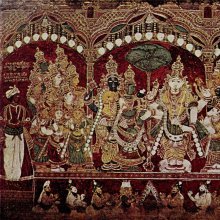Minakshi, Mīnākṣī, Mina-akshi: 13 definitions
Introduction:
Minakshi means something in Hinduism, Sanskrit, the history of ancient India, biology. If you want to know the exact meaning, history, etymology or English translation of this term then check out the descriptions on this page. Add your comment or reference to a book if you want to contribute to this summary article.
The Sanskrit term Mīnākṣī can be transliterated into English as Minaksi or Minakshi, using the IAST transliteration scheme (?).
Images (photo gallery)
In Hinduism
Vaishnavism (Vaishava dharma)
Source: Prabhupada Books: Sri Caitanya CaritamrtaMīnākṣī (मीनाक्षी) refers to a Devī temple near Mādurā.—There are also two Śiva temples, one known as Rāmeśvara and the other known as Sundareśvara. There is also a temple to Devī called the Mīnākṣī-devī temple, which displays very great architectural craftsmanship. It was built under the supervision of the kings of the Pāṇḍya Dynasty, and when the Muslims attacked this temple, as well as the temple of Sundareśvara, great damage was done.

Vaishnava (वैष्णव, vaiṣṇava) or vaishnavism (vaiṣṇavism) represents a tradition of Hinduism worshipping Vishnu as the supreme Lord. Similar to the Shaktism and Shaivism traditions, Vaishnavism also developed as an individual movement, famous for its exposition of the dashavatara (‘ten avatars of Vishnu’).
Shilpashastra (iconography)
Source: Shodhganga: The significance of the mūla-beras (śilpa)Mīnākṣī is the name of deity as found depicted in the Meenakshi Temple in Madurai (or Madura), which represents a sacred place for the worship of The Goddess (Devī).—Mīnākṣī is represented in sama-sthānaka with two hands, the right hand in kapittha holding flower and the left hand in dolā hanging loose. When represented with two hands, the right hand is shown in kaṭaka-hasta and the left hand in dolā-hasta. She is seen in atibhaṅga in samapāda-sthānaka. The goddess comes under the measurement of madhyama-daśatāla.

Shilpashastra (शिल्पशास्त्र, śilpaśāstra) represents the ancient Indian science (shastra) of creative arts (shilpa) such as sculpture, iconography and painting. Closely related to Vastushastra (architecture), they often share the same literature.
Shaktism (Shakta philosophy)
Source: Shodhganga: The significance of the mūla-beras (shaktism)Mīnākṣī (मीनाक्षी) refers to one of the manifestations of Pārvatī or Śakti.—Śrī Mīnākṣī is the mūla-bera of Śrī Mīnākṣī Temple in Madurai. On seeing the mūla-bera of Śrī Mīnākṣī in the garbhagṛha, the devotee stands still in awe and wonder. The goddess is modeled with extreme beauty and grace, radiating serenity. [...] The religious significance of the mūla-bera of Śrī Mīnākṣī is that she has a beautiful forehead and well defined eyebrows. These features ensure a stable and secure income. A well proportionate image would bring happiness to the community. A gracefully rounded neck ensures success in every action. Beautiful thighs would ensure fertile crops, attractive ankles would protect the growth of villages, and pretty feet would foster learning and add to the moral values of the community. As Goddess Śrī Mīnākṣī is a perfect feminine with all the features in perfectness, the devotee who worships her will be filled with abundant fertility and wealth, thus making him/her happy.

Shakta (शाक्त, śākta) or Shaktism (śāktism) represents a tradition of Hinduism where the Goddess (Devi) is revered and worshipped. Shakta literature includes a range of scriptures, including various Agamas and Tantras, although its roots may be traced back to the Vedas.
Ayurveda (science of life)
Nighantu (Synonyms and Characteristics of Drugs and technical terms)
Source: WorldCat: Rāj nighaṇṭuMīnākṣī (मीनाक्षी) is another name for Matsyākṣī an unidentified medicinal plant, possibly identified with either (1) the Kannada synonym Hongonda—Alternanthera sessilis or (2) Enhydra fluctuans Lour., according to verse 5.127 of the 13th-century Raj Nighantu or Rājanighaṇṭu. The fifth chapter (parpaṭādi-varga) of this book enumerates sixty varieties of smaller plants (kṣudra-kṣupa). Together with the names Mīnākṣī and Matsyākṣī, there are a total of five Sanskrit synonyms identified for this plant.

Āyurveda (आयुर्वेद, ayurveda) is a branch of Indian science dealing with medicine, herbalism, taxology, anatomy, surgery, alchemy and related topics. Traditional practice of Āyurveda in ancient India dates back to at least the first millenium BC. Literature is commonly written in Sanskrit using various poetic metres.
General definition (in Hinduism)
Source: Wisdom Library: HinduismMīnākṣī (मीनाक्षी, “fish-eyed”):—In Vedic hinduism, she is the daughter of Kubera and his wife Bhadrā. Kubera is the Vedic God of wealth presiding over all earthly treasures.
India history and geography
Source: Shodhganga: The significance of the mūla-beras (history)Mīnākṣī is another spelling for the Meenakshi Temple in Madurai (or Madura) represents a sacred place for the worship of The Goddess (Devī).—The Nayaks of Madurai were responsible for the grandest religious monuments of the period, such as the double temple dedicated to Mīnākṣī and Sundareśvar in the middle of their capital. The Mīnākṣī Sundareśvar Temple of Madurai is an ancient center of worship as well as an art gallery of vast proportions...
Source: Shodhganga: Temples in KumbakonamMinakshi refers to “the fish-eyed”, according to R.P. Jackson in his “The Dominions, Emblems and Coins of the South Indian Dynasties”.—[While discussing Administration and Socio-Economic Conditions during Vijayanagara Empire, Nayakas, later Pandyas and Marathas (1310–1885 C.E.)]—The special cognizance of the Pandyans was the figure of a fish in various combinations. The king’s title was Minavan (“the fish-one”), and the name of the tutelary deity worshipped in the great temple was Minatchi (Minakshi, “fish-eyed”)

The history of India traces the identification of countries, villages, towns and other regions of India, as well as mythology, zoology, royal dynasties, rulers, tribes, local festivities and traditions and regional languages. Ancient India enjoyed religious freedom and encourages the path of Dharma, a concept common to Buddhism, Hinduism, and Jainism.
Biology (plants and animals)
Source: Google Books: CRC World Dictionary (Regional names)Minaksi in India is the name of a plant defined with Alternanthera sessilis in various botanical sources. This page contains potential references in Ayurveda, modern medicine, and other folk traditions or local practices It has the synonym Telanthera polygonoides Seem. (among others).
Example references for further research on medicinal uses or toxicity (see latin names for full list):
· Taxon (1981)
· Encycl. (Lamarck) (1785)
· Flora of Ecuador (1987)
· Species Plantarum (1753)
· Flora Indica, or ‘Descriptions of Indian Plants’ (1824)
· Systema Vegetabilium (1819)
If you are looking for specific details regarding Minaksi, for example pregnancy safety, side effects, extract dosage, diet and recipes, health benefits, chemical composition, have a look at these references.

This sections includes definitions from the five kingdoms of living things: Animals, Plants, Fungi, Protists and Monera. It will include both the official binomial nomenclature (scientific names usually in Latin) as well as regional spellings and variants.
Languages of India and abroad
Sanskrit dictionary
Source: DDSA: The practical Sanskrit-English dictionaryMīnākṣī (मीनाक्षी).—Name of a deity (worshipped in Madurā).
Mīnākṣī is a Sanskrit compound consisting of the terms mīna and akṣī (अक्षी).
Source: Cologne Digital Sanskrit Dictionaries: Shabda-Sagara Sanskrit-English DictionaryMīnākṣī (मीनाक्षी).—f. (-kṣī) The daughter of Kuvera. E. mīna a fish, and akṣi the eye, ṭac and ṅīṣ affs.
Source: Cologne Digital Sanskrit Dictionaries: Monier-Williams Sanskrit-English Dictionary1) Mīnākṣī (मीनाक्षी):—[from mīna] a f. ‘fish-eyed’, Name of a goddess worshipped at Madurā (commonly called Mīnāci), [Inscriptions; Religious Thought and Life in India 228; 442]
2) [v.s. ...] b f. a species of Soma-plant or of Dūrvā grass, [cf. Lexicographers, esp. such as amarasiṃha, halāyudha, hemacandra, etc.]
3) [v.s. ...] Name of a daughter of Kubera, [Purāṇa]
4) [v.s. ...] of a deity (the deified daughter of a Pāṇḍya king, [especially] worshipped in Madurā and also called Mīnāci), [Religious Thought and Life in India 228; 442 n. 1]
Source: Cologne Digital Sanskrit Dictionaries: Yates Sanskrit-English DictionaryMīnākṣī (मीनाक्षी):—[mīnā+kṣī] (kṣī) 3. f. The daughter of Kuvera.
Sanskrit, also spelled संस्कृतम् (saṃskṛtam), is an ancient language of India commonly seen as the grandmother of the Indo-European language family (even English!). Closely allied with Prakrit and Pali, Sanskrit is more exhaustive in both grammar and terms and has the most extensive collection of literature in the world, greatly surpassing its sister-languages Greek and Latin.
Kannada-English dictionary
Source: Alar: Kannada-English corpusMīnākṣi (ಮೀನಾಕ್ಷಿ):—
1) [noun] a woman having fish-shaped eyes; a woman having beautiful eyes.
2) [noun] the potherb Alternanthera sessilis of Amaranthaceae family.
Kannada is a Dravidian language (as opposed to the Indo-European language family) mainly spoken in the southwestern region of India.
See also (Relevant definitions)
Starts with: Minakshi-Sundareshvara, Minakshicurnika, Minakshipancaratna, Minakshiparinaya, Minakshistavaraja, Minakshistotra.
Full-text (+3): Minakshi-Sundareshvara, Minakshiparinaya, Minakshistotra, Minakshipancaratna, Minakshistavaraja, Minakshicurnika, Tailotsava, Ampikaimalai, Minatci, Meenakshi, Minaksha, Kutal, Parvati, Minatchi, Minavat, Vamana, Kayalvili, Mallika, Amman, Madura.
Relevant text
Search found 18 books and stories containing Minakshi, Mina-akshi, Mīna-akṣī, Mina-aksi, Minaksi, Mīnākṣī, Mīnākṣi; (plurals include: Minakshis, akshis, akṣīs, aksis, Minaksis, Mīnākṣīs, Mīnākṣis). You can also click to the full overview containing English textual excerpts. Below are direct links for the most relevant articles:
Hindu Pluralism (by Elaine M. Fisher)
Language Games of Śiva (Introduction) < [Chapter 4 - The Language Games of Śiva]
The Tiruviḷaiyāṭal Purāṇam in Seventeenth-century Madurai < [Chapter 4 - The Language Games of Śiva]
The Public Theologians of Early Modern South India < [Chapter 1 - Hindu Sectarianism: Difference in Unity]
Pallava period (Social and Cultural History) (by S. Krishnamurthy)
Alvars during the Pallava period < [Chapter 3 - Socio-Religious Life]
Buddhism during the Pallava period < [Chapter 3 - Socio-Religious Life]
Navakandam and Human-sacrifice < [Chapter 3 - Socio-Religious Life]
The Religion and Philosophy of Tevaram (Thevaram) (by M. A. Dorai Rangaswamy)
Chapter 4.3 - (c) Sculptures of Shiva and Dance < [Volume 2 - Nampi Arurar and Mythology]
Chapter 7 - Age of Nampi (Sundarar)—Examined < [Volume 1 - Nampi Arurar’s Tevaram (his life and age)]
Nayanar 57: Pugazh Kotpuli < [Volume 4.1.1 - A comparative study of the Shaivite saints the Thiruthondathogai]
Puranic encyclopaedia (by Vettam Mani)
Kashyapa Shilpa-shastra (study) (by K. Vidyuta)
3. Conclusion (Gopuras) < [Chapter 6 - Conclusion]
Vastu-shastra (5): Temple Architecture (by D. N. Shukla)
Temples of Madura, the final phase (from 1600 A.D.) < [Chapter 12 - History of Hindu Temples (Prāsādas and Vimānas)]


